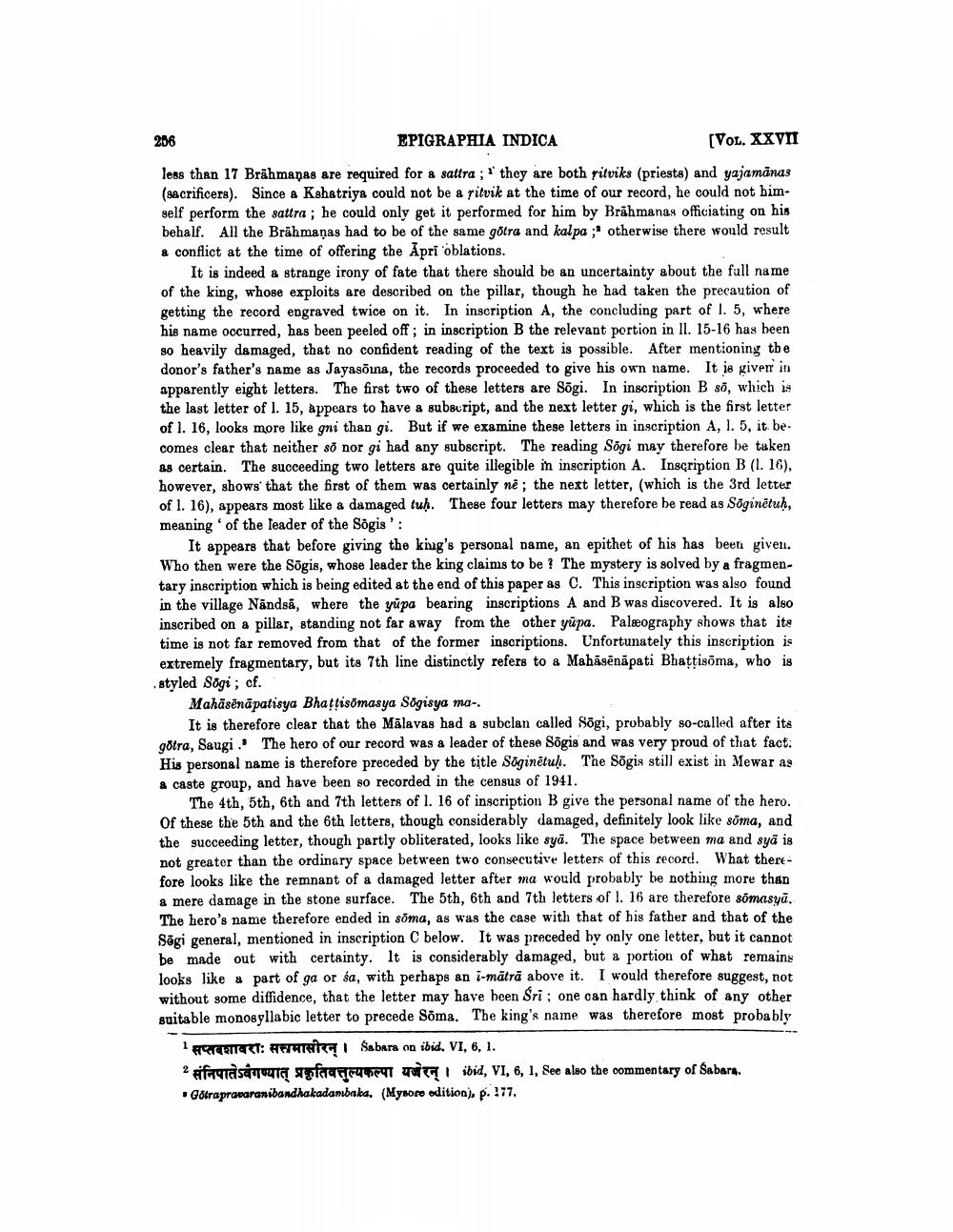________________
206
EPIGRAPHIA INDICA
(VOL. XXVII
less than 17 Brāhmanas are required for å sattra ; " they are both ritviks (priests) and yajamānas (sacrificers). Since a Kshatriya could not be a sitvik at the time of our record, he could not himself perform the sattra; he could only get it performed for him by Brahmanas officiating on his behalf. All the Brāhmaṇas had to be of the same gotra and kalpa ;' otherwise there would result & conflict at the time of offering the Apri oblations.
It is indeed a strange irony of fate that there should be an uncertainty about the full name of the king, whose exploits are described on the pillar, though he had taken the precaution of getting the record engraved twice on it. In inscription A, the concluding part of I. 5, where his name occurred, has been peeled off ; in inscription B the relevant portion in II. 15-16 has been so heavily damaged, that no confident reading of the text is possible. After mentioning the donor's father's name as Jayasõna, the records proceeded to give his own name. It is giverr in apparently eight letters. The first two of these letters are Sögi. In inscription B 30, which is the last letter of I. 15, appears to have a subscript, and the next letter gi, which is the first letter of l. 16, looks more like gni than gi. But if we examine these letters in inscription A, 1.5, it becomes clear that neither 8ð nor gi had any subscript. The reading Sögi may therefore be taken as certain. The succeeding two letters are quite illegible in inscription A. Inscription B (1. 16), however, shows that the first of them was certainly nē; the next letter, (which is the 3rd letter of l. 16), appears most like a damaged tuh. These four letters may therefore be read as Söginētuh, meaning of the leader of the Sögis':
It appears that before giving the king's personal name, an epithet of his has been given. Who then were the Sögis, whose leader the king claims to be? The mystery is solved by a fragmentary inscription which is being edited at the end of this paper as C. This inscription was also found in the village Nändsä, where the yüpa bearing inscriptions A and B was discovered. It is also inscribed on a pillar, standing not far away from the other yüpa. Palæography shows that ite time is not far removed from that of the former inscriptions. Unfortunately this inscription is extremely fragmentary, but its 7th line distinctly refers to a Mahasenapati Bhattisöma, who is styled Sogi; cf.
Mahäsènäpatisya Bhattisomasya Sögisya ma-.
It is therefore clear that the Mālavas had a subclan called Sõgi, probably so-called after its gðtra, Saugi.' The hero of our record was a leader of these Sögis and was very proud of that fact. His personal name is therefore preceded by the title Söginētuh. The Sögis still exist in Mewar as a caste group, and have been so recorded in the census of 1941.
The 4th, 5th, 6th and 7th letters of l. 16 of inscription B give the personal name of the hero. Of these the 5th and the 6th letters, though considerably damaged, definitely look like soma, and the succeeding letter, though partly obliterated, looks like sya. The space between ma and syā is not greater than the ordinary space between two consecutive letters of this record. What there fore looks like the remnant of a damaged letter after ma would probably be nothing more than a mere damage in the stone surface. The 5th, 6th and 7th letters of l. 16 are therefore sömasvā. The hero's name therefore ended in soma, as was the case with that of his father and that of the Sögi general, mentioned in inscription C below. It was preceded by only one letter, but it cannot be made out with certainty. It is considerably damaged, but a portion of what remains looks like a part of ga or sa, with perhaps an i-mātrā above it. I would therefore suggest, not without some diffidence, that the letter may have been Sri: one can hardly think of any other suitable monosyllabic letter to precede Soma. The king's name was therefore most probably
rataract: HARI Sabara on ibid. VI, 6, 1. 2 rifaruiasámuuta safragrau
I ibid, VI, 6, 1, See also the commentary of Sabara. GStrapravaranibandhakadambaka. (Mysore edition), p. 977,




